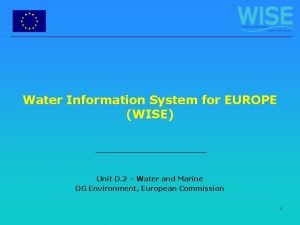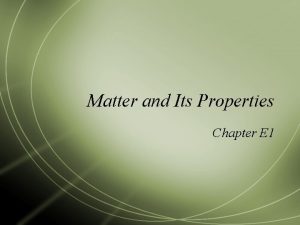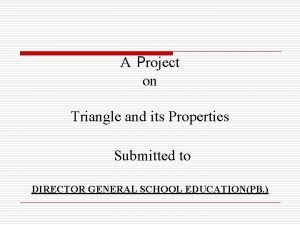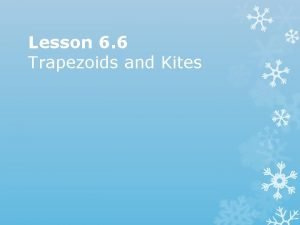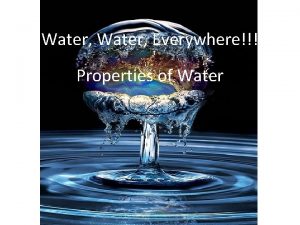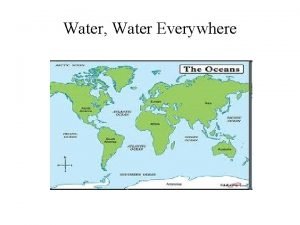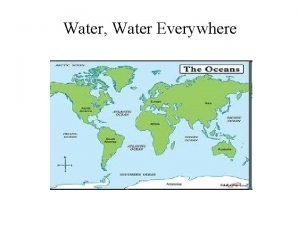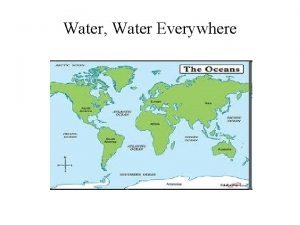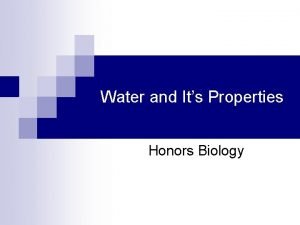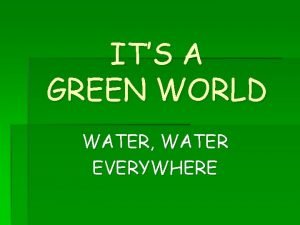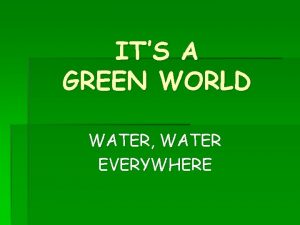Properties of Water Water its everywhere Water is















- Slides: 15

Properties of Water

Water- it’s everywhere! �Water is the key to our survival on Earth, it is our source of life �Water is everywhere! It makes up about 70% percent of the Earth’s surface �Of that water, about 97% is ocean, and only 3% is fresh water

Chemical make-up �Water has the chemical formula H 2 O. A water molecule contains one oxygen and two hydrogen atoms connected by covalent bonds.

Below freezing Above boiling Between freezing and boiling SOLID- LIQUID- GAS THREE STATES OF WATER SOLID LIQUID GAS

Physical Changes of Water � Condensation GAS LIQUID � Evaporation LIQUID GAS � Freezing LIQUID SOLID � Melting SOLID LIQUID � Sublimation SOLID GAS � Frost Formation GAS SOLID

Fun Fact! � Most liquids contract (get smaller) when they get colder. Water is different. Water contracts until it reaches 4 C then it expands until it is solid. � So, solid water is less dense than liquid water! � If water worked like other liquids, then there would be no such thing as an ice berg, the ice in your soft drink would sink to the bottom of the glass, and ponds would freeze from the bottom up!

The Water Cycle! �Evaporation �Condensation �Precipitation �Collection

Evaporation �Evaporation is when the sun heats up water in rivers or lakes or the ocean and turns it into vapor or steam. The water vapor or steam leaves the river, lake or ocean and goes into the air.

Condensation �Condensation: Water vapor in the air gets cold and changes back into liquid, forming clouds �EXAMPLE: Water forms on the outside of a cold glass on a hot day. That water didn't just leak through the glass! It actually came from the air. Water vapor in the warm air turns back into liquid when it touches the cold glass.

Precipitation �Precipitation occurs when so much water has condensed that the air cannot hold it anymore. The clouds get heavy and water falls back to the earth in the form of rain, hail, sleet or snow.

Collection �When water falls back to earth as precipitation, it may fall back in the oceans, lakes or rivers or it may end up on land. �When it ends up on land, it will either soak into the earth and become part of the “ground water” that plants and animals use to drink or it may run over the soil and collect in the oceans, lakes or rivers where the cycle starts all over again!

Adhesion and Cohesion �Adhesion Cohesion

Adhesion and Cohesion �Water is attracted to other water. This is called cohesion. Water can also be attracted to other materials. This is called adhesion � The oxygen end of water has a negative charge () and the hydrogen end has a positive charge (+). The hydrogens of one water molecule are attracted to the oxygen from other water molecules. This attractive force is what gives water its cohesive and adhesive properties.

Surface Tension � Surface tension is the name we give to the cohesion of water molecules at the surface of a body of water � EXAMPLE: When you place a drop of water onto a piece of wax paper, molecule in the water drop is attracted to the other water molecules in the drop. (there is no adhesion between the drop and the wax paper) � This causes the water to pull itself into a shape with the smallest amount of surface area, a bead (sphere). All the water molecules on the surface of the bead are creating surface tension � EXAMPLE: When you float a pin or a paperclip on the top if a glass of water, the water is able to hold up the metal even though the paper clip is heavier than water. � Surface tension is not the force that keeps boats floating

Capillary Action � Surface tension is related to the cohesive properties of water. � Capillary action however, is related to the adhesive properties of water. � EXAMPLE: You can see capillary action 'in action' by placing a straw into a glass of water. The water 'climbs' up the straw. One water molecule moves closer to a the straw molecules the other water molecules (which are cohesively attracted to that water molecule) also move up into the straw. Capillary action is limited by gravity and the size of the straw. The thinner the straw or tube the higher up capillary action will pull the water. � Plants take advantage of capillary action to pull water from the into themselves. From the roots water is drawn through the plant by another force, transpiration.
 Everywhere you go everywhere you look
Everywhere you go everywhere you look A paved blacktop parking lot was built
A paved blacktop parking lot was built Water water everywhere project
Water water everywhere project Unit 11 water water everywhere
Unit 11 water water everywhere Water and water and water water
Water and water and water water They accuse me of being dark in their free city
They accuse me of being dark in their free city When a train increases its velocity its momentum
When a train increases its velocity its momentum Sunny rainy cloudy windy stormy
Sunny rainy cloudy windy stormy If its a square it's a sonnet summary
If its a square it's a sonnet summary Its halloween its halloween the moon is full and bright
Its halloween its halloween the moon is full and bright Its not easy but its worth it
Its not easy but its worth it Matter and its properties
Matter and its properties Project on triangle and its properties
Project on triangle and its properties Notes 6-6: properties of kites and trapezoids
Notes 6-6: properties of kites and trapezoids Extensive and intensive examples
Extensive and intensive examples Is smell a physical property
Is smell a physical property



